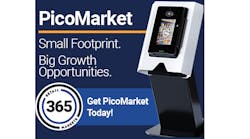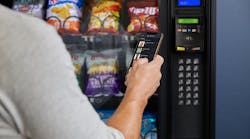What’s trending in vending and micro markets – and what’s likely to stick
People are headed back to the office, but not in the way that we think. The transition to hybrid work for many white-collar jobs during the pandemic may actually be here to stay. A study done by The Partnership for New York City surveyed more than 160 major employers in the city and as of mid-April 2022, only 38% of Manhattan office workers were currently at the workplace on an average weekday. Only 8% were in the office five days a week. They expect that return to office rates will increase after Labor Day, with 49% of workers expected in the office on an average weekday in September 2022. However, the survey found that remote work is here to stay, with 78% of employers indicating they will keep a hybrid office model. While this survey is small and showcases just one major city in the U.S., it highlights that the hybrid work model is the “new norm,” at least for now.
What this means for vending and micro market operators wishing to succeed is a requirement to look at changing consumer purchasing habits and preferences, to seek opportunities outside of “traditional” bounds, and to re-engage with already loyal customers.
Change in purchasing habits
Ryan McWhirter, vice president of product management at 365 Retail Markets, notes that in the last year, the products people are buying have not changed much.
“Coffee, water and soda continue to lead the pack with subtle changes within the category,” he said. However, the devices people use to buy those products have greatly diversified.
“The addition of PicoCooler and PicoMarket alongside the scan and pay capability inside the 365Pay app have provided operators with a host of options to provide across their Connected Campus. With the addition of Order Ahead inside 365Pay in 2020 and food pickup lockers introduced in 2021, we are also seeing a spike in order-ahead orders, just like the Panera Breads and Chipotles of the world. When it comes to payment types, both the 365Pay app and NFC-based transactions continue to rise on the kiosk, both of which help to enable our touchless transaction technology.”
An important trend at the 2022 NAMA Show included new technologies from manufacturers that offer consumers the choice to pay how they prefer. PayRange Inc. announced it has added capabilities to accept store gift cards and cryptocurrencies. Hundreds of store gift cards are supported including Target, Starbucks, Walmart, Home Depot, Lowes, Apple, and more. To pay with cryptocurrency, users can sign into their Coinbase account within the PayRange app and fund with Bitcoin, among others.
And earlier this summer, Cantaloupe announced it has integrated Vendekin's Retrobox, a patented hardware-enabled SaaS product to make vending machines touchless and smart, supporting frictionless experiences for consumers. Consumers will be able to scan the machine's QR code, select items from a menu of all the offerings in the machine and pay for their selection, all from their smartphone or via Cantaloupe’s ePort card reader.
“I believe one of the greatest changes from the pandemic has been the acceleration of unattended retail and self-service applications that are now a preferred way to shop by consumers,” said Elyssa Steiner, vice president of marketing at Cantaloupe. “One of the biggest trends from a payment perspective is that consumers prefer to tap more than ever. Whether they are buying from a vending machine, micro market, or even in traditional retail, consumers are leveraging contactless forms of payments to complete a transaction. We’ve seen on some of our most popular card readers that contactless now makes up over 50% of all cashless transactions,” she added. “Oftentimes, the biggest challenge in enabling new ways for consumers to pay, is to break their old habits, and COVID did just that. Now consumers know the ease of tapping their card or mobile phone and I think we’ll see this trend continue to grow even into the future.”
McWhirter adds that while touchless features have plateaued since mid-2021, the speed and convenience of the transaction and those principles will continue to inform new user experiences going forward. “At 365 Retail Markets, we were fortunate to have already had touchless checkout capacity on our kiosks prior to the COVID-19 pandemic. That said, we did add some capabilities to our 365Pay app around touchless coffee and vending so consumers could engage with those devices similarly,” he noted.
Growth in self service
Not only do consumers want to pay with any and all methods, they also prefer to shop at their own pace and oftentimes choose self-service. Look no further than the rise in self-service checkouts at grocery stores and QSRs like McDonald’s. In the education session “Unattended Retail in Foodservice: Consumer Trends in the Evolving Space” at the 2022 NAMA Show, PepsiCo’s Bill Moxey cited a 2018 study from McDonald’s in which the company found that consumers wanted more control of the transaction.
“Consumers wanted to know exactly what they were getting and that they could put it back if they changed their mind. The irony is that those consumers bought more from the kiosk than they did from a server at the counter,” he said. “When consumers feel less pressure, they feel more comfortable and they buy more. In this fast-paced world that we live in, we need to give consumers time to think and not feel pressure.”
Cantaloupe’s Steiner echoed these sentiments. “Consumers don’t want to interact with humans to complete a transaction and, in some cases, find self-checkout far easier and safer to use. This trend is proven through the acceleration of kiosks not only in retail or grocery stores, but also in places like airports, train stations and more,” she said.
In the education session, “Retail Reimagined: An Interview with Experts,” Robert Gebhardt, VP Experience Services Lead America at Jones Lang LaSalle, noted that the pandemic changed the way consumers shop; therefore, businesses need to rethink how they sell to a consumer.
"When the pandemic hit, we were all forced to do the same thing: pack your bags and go home. I think there was an instantaneous fear that the office environment is dead, that it's never going to return, but that is absolutely the furthest thing from the truth,” he said. “But this change requires us to think differently. We need to follow that employee along on their journey while they are at home, while they are on their way into the office, while they are in the office and as they plan to leave the office. We need to think about all the opportunities that we have to engage with them."
This may mean operators look beyond traditional vending solutions toward more scalable self-service solutions, creating a one-stop-shop for the customer.
Opportunities abound
For operators looking toward the future, experts recommend thinking outside of traditional vending offerings. “Think outside of snacks and sodas,” said David Ashforth, co-founder of Digital Media Vending International. “Almost anything you can imagine can be dispensed now. America is the land of opportunity and innovation, it's time for operators to innovate and think outside of the box.”
Cantaloupe’s Steiner agrees. “I think operators must be willing to expand outside of food and beverage,” she said. “Self-service is growing at a rapid pace, and there is tremendous opportunity for operators who have distribution models already set up, to capitalize on these trends for other consumable products. I think the biggest challenge is getting out of that mindset that this is only a food and beverage industry. Operators don’t have to do just food and beverage anymore. They can diversify their business and be a tool for other retail establishments to expand because they have the routing, logistics, warehouse and processes that make servicing, managing and restocking self-service locations efficient.”
"Operators don’t have to do just food and beverage anymore. They can diversify their business and be a tool for other retail establishments to expand because they have the routing, logistics, warehouse and processes that make servicing, managing and restocking self-service locations efficient.” – Elyssa Steiner, Cantaloupe
She recommends that operators take action on testing and trying new applications, including taking micro markets or smart coolers into locations that weren’t previously considered, such as apartment complexes, hotels, etc. It could also mean expanding vending machines to include a wider variety of consumer products. “There is tremendous growth and opportunity in self-service, and it really is the future of how consumers want to shop because it’s fast, convenient and safe – so why not capitalize on it,” she noted.
This expansion of ideas outside of traditional vending locations was on display at the NAMA Show earlier this year. 365 Retail Markets showcased its new MM6 Kiosk for Dining, which is also available in micro market mode, and its Stockwell 2.0, a no-checkout smart technology that combines refrigerated and ambient design. It gives operators the ability to sell beverages and fresh food alongside snacks and dry goods.
This expansion of ideas outside of traditional vending locations was on display at the NAMA Show earlier this year. 365 Retail Markets showcased its new MM6 Kiosk for Dining, which is also available in micro market mode, and its Stockwell 2.0, a no-checkout smart technology that combines refrigerated and ambient design.
Other showcased products and technologies, including Remote Laundry Room, Nayax’s Bee Meter and Parlevel’s Hubz Smart Cooler, displayed different ways for attendees to think beyond traditional vending and look at new opportunities within the industry.
“Post COVID, the days of selling PPE and other COVID-related consumables are over,” added Ashforth. “Consumers are increasingly more amenable to using smart vending machines that can convey a brand's look and feel. But, as with everything, it's all about convenience and finding what you want, when you want it.”
He points to several innovative concepts that are meeting this consumer need. “Food banks are using temperature controlled lockers to conveniently deliver food to people who need it.” His company also developed a C-Store machine that can extend up to 32 feet wide and offer almost everything a regular store can offer. “Unmanned retail is the future, and with an economic downturn ahead, companies will be looking to use large, smart vending machines to reduce shrinkage and save on labor costs,” Ashforth continued.
“Unmanned retail is the future, and with an economic downturn ahead, companies will be looking to use large, smart vending machines to reduce shrinkage and save on labor costs.” – David Ashforth, Digital Media Vending International
Steiner believes that the industry is at an inflection point where technology is changing faster than ever before, and operators are dealing with real challenges such as labor shortages and inflation. When it comes to opportunities, she notes there are two sides to consider: first, opportunities to grow their business and expand into new self-service applications, and second, opportunities to leverage technology to solve the day-to-day challenges that are affecting their bottom line – labor and inflation.
“If we talk about growth in self-service, I think there is tremendous opportunity for operators to look at vending machines outside of traditional food and beverage, whether that’s partnering with consumer product brands or taking self-checkout kiosks and extending micro markets into more public locations through technology like smart coolers,” said Steiner. “Then, if we look at opportunities to solve for key challenges they are facing in their operation, features like remote price change available in Cantaloupe’s Seed platform, used to update prices remotely at your machines – just like operators do in micro markets – can save them tremendous time and money, especially given the labor and inflation challenges they are facing in today’s economy.”
365’s McWhirter adds that returning to the office is a growing focus for many organizations and something on which operators need to capitalize. “Operators have a unique opportunity to support this transition by offering programs that incentivize and reward employees in the workplace,” he said. “Over the past year, the industry has seen a rise in the use of promotions, as well as loyalty and subsidy programs. Through our product solutions, operators can leverage any mix of all three, depending on client needs. The days of opening a micro market and gifting everyone a one-time, minute stipend has shifted. 365 has seen an increase in collaborations between foodservice operators (FSO) and their clients, through which the clients contribute amounts such as $5 per week or $10 per month toward purchase credits.”
“Operators have a unique opportunity to support this transition by offering programs that incentivize and reward employees in the workplace. Over the past year, the industry has seen a rise in the use of promotions, as well as loyalty and subsidy programs." – Ryan McWhirter, 365 Retail Markets
Looking forward
The vending and micro market industry continues to innovate; those operators who stay knowledgeable on upcoming trends and technologies are those who plan to be in the business for the long haul. Digital Media Vending International’s Ashforth believes that when it comes to vending machine technology, there are a few things that will become the norm in the next several years. “Touchless, cashless, robotics, elevators or conveyor belts to deliver a product to the customer without the customer having to touch the machine,” he said.
Steiner agrees, adding, “Now you see technology around facial recognition that could be the next phase to allowing consumers to pay without the need to carry their wallet or touch a self-service machine to complete a transaction.”
Despite the economic setbacks faced in 2020 and beyond, there are many opportunities in the vending and micro market industry for those operators willing to look ahead.

Adrienne Klein | Contributing Editor
Adrienne Zimmer Klein is a freelance writer with a background in the vending, micro market and office coffee service industry. She worked as an associate editor and managing editor at Automatic Merchandiser and VendingMarketWatch.com from 2013 until 2017. She is a regular contributing writer at Automatic Merchandiser.









